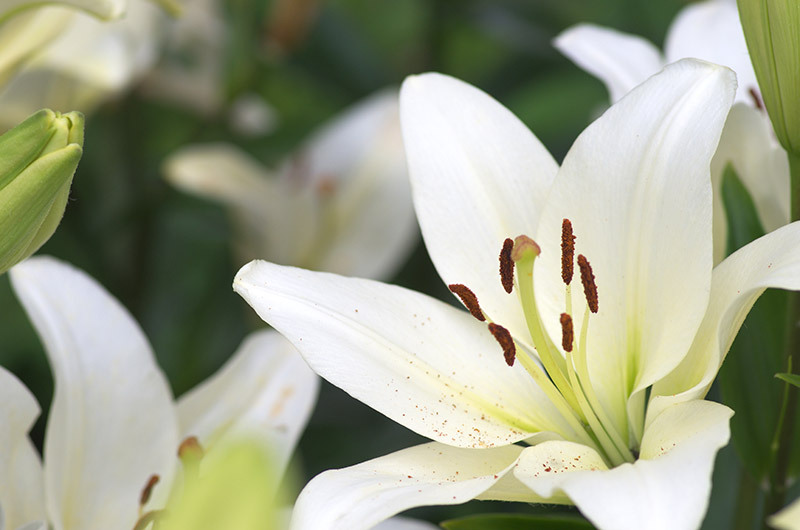Insider Knowledge for Hydrangea Enthusiasts
Posted on 27/08/2025
Insider Knowledge for Hydrangea Enthusiasts: A Comprehensive Guide
Hydrangeas are cherished worldwide for their breathtaking blooms and versatility in gardens, landscapes, and floral arrangements. Whether you're a seasoned gardener or a newcomer aiming to enhance your outdoor space, harnessing insider knowledge can elevate your hydrangea-growing experience. This in-depth guide compiles expert tips, tricks, and secrets for true hydrangea lovers, ensuring your hydrangeas thrive and delight season after season.
Understanding Hydrangea Varieties: Choosing the Right Type
Not all hydrangeas are created equal. Knowing the key differences between popular varieties is crucial for optimal selection and care. Here are the most notable hydrangea types:
Bigleaf Hydrangea (Hydrangea macrophylla)
- Features: Rounded "mophead" or lacecap blooms, large glossy leaves.
- Color: Blue, purple, or pink flowers--color changes with soil pH.
- Notes: Sensitive to cold; best in USDA zones 6-9.
Panicle Hydrangea (Hydrangea paniculata)
- Features: Cone-shaped clusters, robust growth, excellent for colder climates.
- Color: White flowers that may mature to pink or lime-green.
- Notes: Hardy, tolerates pruning, blooms on new wood.
Smooth Hydrangea (Hydrangea arborescens)
- Features: Large spherical blooms, reliable shrub for North American gardens.
- Color: Typically white, sometimes pale green or pink.
- Notes: Native to the US; includes famous 'Annabelle' cultivar.
Oakleaf Hydrangea (Hydrangea quercifolia)
- Features: Oak-shaped leaves, stunning fall color, looser flower clusters.
- Color: White blooms turning pink or purple in autumn.
- Notes: Thrives in partial shade; adds four-season interest.
Insider tip: Experiment with planting several hydrangea types in your garden to take advantage of their diverse bloom times and leaf textures, ensuring vibrant color from spring through fall.

Soil Secrets: pH, Drainage, and Amendment
Soil is the foundation of healthy hydrangea growth. Follow these expert techniques to promote lush foliage and striking flowers:
- Test soil pH: Hydrangeas, especially macrophylla varieties, are famous for flower color variation based on acidity. Blues emerge in acidic (< 6.0 pH) soil, while pinks dominate in alkaline environments. A simple soil test kit can guide amendments.
- Improve drainage: Hydrangeas dislike "wet feet." Amend compacted clay with organic compost, coarse sand, or perlite to improve structure and prevent root rot.
- Add organic matter: Incorporate well-rotted leaf mold, manure, or compost each spring to boost nutrient levels and support beneficial soil microbes.
Advanced insider knowledge: For more intensely colored blooms, use aluminum sulfate for blue flowers or lime for pink and red tones. Always apply gradually and monitor plant response to avoid injury.
Planting Hydrangeas for Impact
The initial planting technique dramatically affects a hydrangea's success. Here are best practices from seasoned hydrangea growers:
- Timing matters: Plant in early spring or fall, when temperatures are mild and rainfall is more abundant.
- Site selection: Most hydrangeas prefer morning sun and afternoon dappled shade. Avoid locations exposed to strong afternoon sun or harsh winter winds.
- Spacing: Hydrangeas need room to spread--typically 3 to 8 feet apart depending on variety. Crowding limits airflow and encourages disease.
Expert tip for containers
Hydrangeas adore pots with good drainage. Use a rich, moisture-retaining mix and rotate containers throughout the seasons for optimal sunlight and protection.
Hydrangea Care Throughout the Seasons
Spring: Awakening and Early Growth
- Pruning: Panicle and smooth hydrangeas bloom on new wood, so prune in late winter or early spring. Bigleaf and oakleaf types bloom on old wood--only remove spent flowers or dead stems.
- Fertilize: Apply a balanced slow-release fertilizer as buds swell, being careful not to overfeed, which creates leafy growth at the expense of blooms.
Summer: Peak Bloom and Maintenance
- Water consistently: Hydrangeas require moist (but not waterlogged!) soil to produce large, healthy flowers. Mulch generously to retain moisture and suppress weeds.
- Deadhead: Remove spent blooms to encourage new flower clusters and a tidy, attractive plant.
Fall: Preparing for Dormancy
- Don't over-prune: Especially with bigleaf and oakleaf hydrangeas, prune sparingly in the fall to avoid removing next year's buds.
- Add mulch: A thick layer of straw or bark protects roots through winter, especially in colder climates.
Winter: Protection and Rest
- Insulation: In harsh regions, wrap the base of hydrangeas with burlap or use wire cages stuffed with leaves to shield buds from temperature extremes.
- Resist overwatering: Hydrangeas are dormant and need minimal irrigation. Water only if soil is bone dry and unfrozen.
Hydrangea Flower Color: Science and Magic
One of the greatest joys (and mysteries) for hydrangea enthusiasts is manipulating bloom colors. Here's how to achieve your favorite shades:
- Aluminum and pH: Blue shades require both low pH and available aluminum in soil. Acidify with sulfur or peat moss, and apply aluminum sulfate carefully.
- Alkaline for pinks: Raise pH with garden lime for vivid pink or even red hues. Monitor over time, as results take a growing season or more to manifest.
- White hydrangeas: Typically, flower color in white varieties does not change with soil pH, due to lack of specific pigments.
Key insight: Consistency is everything! Frequent, small soil amendments combined with annual soil tests are crucial for stable, repeatable hydrangea colors.
Propagation Tips: Growing Your Hydrangea Collection
Hydrangeas are surprisingly easy to propagate with a few insider secrets:
Stem Cuttings
- Select healthy shoots: In early summer, cut a non-flowering stem just below a node. Remove lower leaves.
- Dipping in rooting hormone: This increases success rates dramatically.
- Rooting medium: Insert into moist perlite or a blend of peat and sand. Keep warm and covered until roots form in 2-4 weeks.
Layering
- Bend a low-growing branch: Bury a portion under soil, securing with a stone or pin.
- Wait for roots: By late season, cut the rooted section free and transplant.
Advanced tip: Hydrangeas grown from cuttings often outperform store-bought plants in vigor--especially when acclimated to your specific garden conditions.
Dealing with Common Hydrangea Problems
Even expert gardeners encounter challenges. Here's how to address the most frequent hydrangea issues:
Wilting and Leaf Burn
- Causes: Underwatering, excessive sun, or root damage.
- Remedy: Increase shade, mulch roots, and water deeply but infrequently.
Fungal Diseases
- Symptoms: Leaf spots, powdery mildew, and stem blight.
- Prevention:
- Space hydrangeas for airflow.
- Water at the base, not overhead.
- Remove all infected leaves and debris promptly.
- Use fungicidal sprays if infestations are severe.
Pests
- Common Culprits: Aphids, spider mites, slugs, and scale insects.
- Solutions: Blast aphids with water, use insecticidal soap, and hand-pick slugs. Encourage natural predators like ladybugs.
Designing with Hydrangeas: Creative Uses in Your Garden
The real magic of an insider hydrangea enthusiast is using these versatile shrubs for maximum beauty. Mix and match hydrangeas in beds, borders, and containers to stunning effect:
- Use as foundation plants: Hydrangeas anchor borders and create a lush, classic backdrop for perennials and bulbs.
- Create living fences: Closely spaced rows of panicle or oakleaf hydrangea make a beautiful, private screen.
- Seasonal containers: Combine dwarf hydrangea varieties with trailing annuals for spectacular patio displays.
- Focal points: Feature a specimen shrub under a window or at a gateway, surrounded by shade-loving companions like hostas and ferns.
- Cut flowers: Harvest blooms when they're just fully open for vases, or wait until they've dried on the plant for long-lasting indoor arrangements.
Hydrangeas and Climate: Adapting to Your Region
Hydrangea performance can vary with local conditions, but with some insider adjustments, you'll succeed nearly anywhere:
- Hot climates: Select panicle hydrangeas and give afternoon shade. Mulch extra-thick and water regularly.
- Cold climates: Focus on smooth and panicle types, which withstand harsher winters. Protect macrophylla and oakleaf varieties with insulation and wind blocks.
- Urban gardens: Dwarf hydrangeas thrive in containers and compact plots. Group containers for humidity and move them seasonally for best light.

Insider Knowledge FAQs: Expert Answers for Hydrangea Enthusiasts
- Q: Why won't my hydrangea bloom?
- A: Late frosts, improper pruning, or too much shade may be to blame. Review variety-specific pruning habits and protect early buds if needed.
- Q: How do I keep blue hydrangeas blue?
- A: Maintain acidic soil (pH 5.2-5.5), apply aluminum sulfate in spring, and monitor pH annually to prevent drift.
- Q: Are hydrangeas deer-resistant?
- A: Unfortunately, no. While panicle and oakleaf may be slightly less palatable, fences and repellents work best where deer are present.
- Q: Can I grow hydrangeas indoors?
- A: Certain small varieties will bloom indoors with bright but indirect light and careful watering, but most thrive best outdoors.
Conclusion: Embrace Your Inner Hydrangea Insider
For true hydrangea enthusiasts, growing these captivating shrubs is both an art and a science. By leveraging insider knowledge--choosing the right variety, enhancing soil, employing strategic care through the seasons, and creatively designing your landscape--you can unlock the full potential of your hydrangea collection. As you cultivate and enjoy these remarkable plants, you'll join a passionate community of fellow gardeners dedicated to the joy, beauty, and wonder of hydrangeas.
Ready for your best hydrangea garden yet? With these strategies, your blooms will be the envy of every neighbor and the pride of every season.
- Experiment fearlessly with varieties and garden locations.
- Test and amend your soil for ultimate color control.
- Master pruning, protection, and propagation to multiply your success.
- Get creative with your designs and share your passion with others!
Hydrangea expertise is just a season away--start applying these insider secrets today for gardens bursting with life, vibrancy, and timeless charm.
Latest Posts
Insider Knowledge for Hydrangea Enthusiasts
Expressing Love with Red Roses: The Valentine's Day Custom
Unlock 8 Thrilling Sunflower Facts That Will Surprise You
Connect With Your Birth Flower and Tap Into Its Symbolic Wisdom





